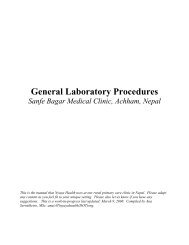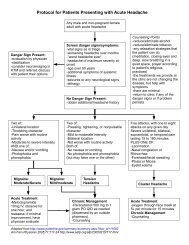Protocol for Patients Presenting with Abscess, Cellulitis - Nyaya Health
Protocol for Patients Presenting with Abscess, Cellulitis - Nyaya Health
Protocol for Patients Presenting with Abscess, Cellulitis - Nyaya Health
Create successful ePaper yourself
Turn your PDF publications into a flip-book with our unique Google optimized e-Paper software.
<strong>Protocol</strong> <strong>for</strong> <strong>Patients</strong> <strong>Presenting</strong> <strong>with</strong><strong>Abscess</strong>, <strong>Cellulitis</strong>, Furuncle, or CarbuncleDanger signs present-immediate evaluation by a physician-address predisposing/immunocompromising conditions-consider IV antibiotics: cefazolin1gm IV Q8H-<strong>for</strong> patients <strong>with</strong> penicillin allergy orevidence of anaerobic infection(crepitation or bullae), use Penicillin 3million units IV q4h, plus Clindamycin600 mg IV q6h-if concern <strong>for</strong> necrotizing fasciitis,use both cefazolin and clindamycinas noted above-consider surgical intervention <strong>for</strong>deeper soft tissue infection orabscess-consider anticoagulation if clinicallyconsistent <strong>with</strong> DVT-24 hour observationAny patient presenting <strong>with</strong> an area oftenderness, redness, swelling, or painScreen danger signs/symptoms-systemic signs: temperature >38.0, heart rate>100, systolic blood pressure
Notes (typically do not need to be printed out at the clinic; just <strong>for</strong> reference and documentation)We group these skin infections together owing to common/similar presentation. We are developingadditional protocols <strong>for</strong> other soft tissue infections such as impetigo, necrotizing infections, and bitewounds.<strong>Abscess</strong>es do not typically require antibiotics. Having cellulitis around an abscess does not requiretreatment in the absence of either fever, toxic appearance, or immunocompromise, all of which werescreened out in the protocol. The exceptions would be: 1. if it's huge and extending (say, >10 cm,although there isn't a <strong>for</strong>mal cut-off). 2. if the abscess can't be drained well. There is anecdotalevidence, which has led to widespread use in our setting, that, owing to the difficulties <strong>with</strong> patientfollow-up and wound hygiene, abscesses should be treated <strong>with</strong> antibiotics. We currently do not doso, as there is no evidence <strong>for</strong> it, and will focus on patient education and follow-up throughcommunity health workers to prevent adverse outcomes. However, we will be carefully documentingoutcomes and may adjust as necessary.Ciprofloxacin should not be used <strong>for</strong> cellulitis. Not only is it less studied (more in abscess than incellulitis), but even if it works it should be spared b/c of its low genetic barrier to resistance,particularly when the other choices are adequate and well established. Although quinolones haveconvenient dosing, microbial susceptibility won't last long. Quinolones also should be used <strong>with</strong>extreme care in an area <strong>with</strong> TB.Injecting lidocaine into an abscess is not appropriate. It's painful and ineffective. Rather, it isnecessary to inject into tissue where the nerves are, not into a tight pocket of pus which: 1) becomestense <strong>with</strong> pain; 2) isn't where the nerves are; 3) would make the lido incredibly diluted by pusanyways. A field bloc is not painful, requires only one to two injections, only the first of which is felt,produces much less pain. To quote from a surgery book on local <strong>for</strong> abscesses: "Injection into theabscess cavity is ineffective and can exacerbate discom<strong>for</strong>t by increasing the intracavitary pressure."This is also the recommended procedure from the WHO Essential surgical care.





